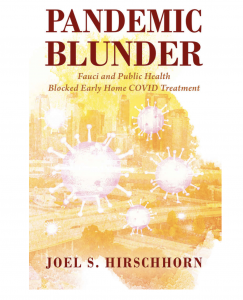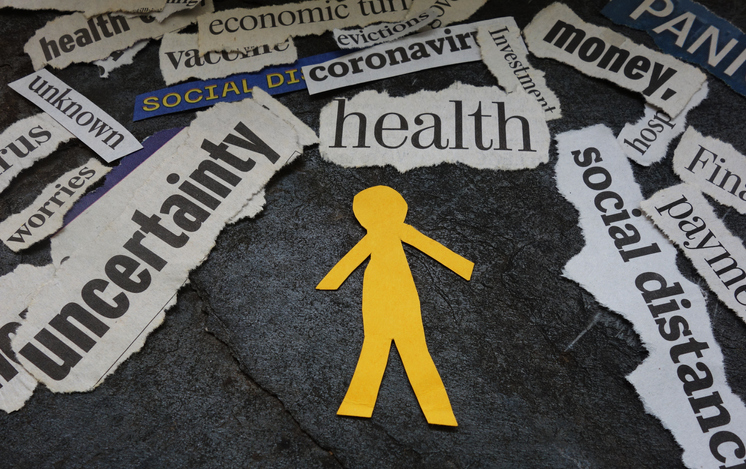Review of Pandemic Blunder: Fauci and Public Health Blocked Early Home COVID Treatment, Outskirts Press, 2021, By Joel S. Hirschhorn, $17.95, 106 pages
When the history books are written on “the great pandemic of 2020,” they will likely focus on one theme: how powerful government agencies and special interests used a virus to dupe the American people for political and self-promoting agendas.
This is not to diminish the fact that COVID has been deadly. With 500,000 lives lost, it absolutely has been—but the leaders we have entrusted to protect the nation could have greatly reduced this pain and suffering and failed to do so. Was it incompetence or malfeasance? That is the question Joel Hirschhorn seeks to answer in his excellent and timely summary of events, entitled Pandemic Blunder: Fauci and Public Health Blocked Early Home COVID Treatment. Upon finishing, readers will wonder if Hirschhorn was too kind in the use of the word, “blunder.” What he describes is far more outrageous—a conspiracy, really, the action of plotting to do something unlawful or harmful.
Hirschhorn makes the case that COVID-19 could have been a manageable disease, and tens of thousands of people could have been kept alive, had government agencies supported cheap, safe, and existing drugs to treat infection at home during its early stages – before the virus replicates and does its deadly damage. There are numerous observational and “real-life data” studies showing the effectiveness of early treatment for COVID-19 infection.
Had this information seen the light of day in the mainstream media or not been censored on social media or discredited by powerful government bureaucrats and the medical establishment, including a fake study now retracted by two of the world’s top “peer-reviewed” medical journals, people would not have panicked into surrendering their cherished life, liberty, and pursuit of happiness.
The Pillars of Control
Pandemic Blunder documents a great deal of scientific information on early COVID treatment and presents it in a way that a general audience would understand. The book begins with a description of what many public health experts, but most notably Peter McCullough, M.D., have described as the four pillars to controlling a pandemic.
One pillar is contagion control, which the United States and countries around the globe have done with abandon. This would include lockdowns, social distancing orders, disinfection of surfaces, mask mandates, crowd control, and the like. Government agencies have been very effective in getting the public to comply with these measures, but tragically, these steps have done little to reduce caseloads and deaths. By spring, it became apparent the most vulnerable individuals to the virus were the elderly, especially those in group homes. Yet nine months after many of these measures were put in place, elderly patients in nursing homes still topped the charts for COVID mortality.
A second pillar has been hospitalization. The current guidance from the nation’s health agencies has been to do nothing for infection, outside of comfort care, until symptoms become worse. Once in the hospital, the chances of survival plummet while the costs soar. Hirschhorn describes how the National Institutes of Health (NIH) has poured much effort into fast-tracking experimental and off-label treatments for COVID-19. One such treatment is Remdesivir, an experimental treatment that can only be administered in a hospital at a cost of thousands of dollars a dose.
The government has also poured billions of dollars into pillar number three: vaccines. Vaccines are always a gamble. Safe and effective vaccines can take years to develop and, oftentimes, contagions fade away after herd immunity is naturally established. Additionally, viruses mutate, making prevention that much more difficult to target. Think of the flu vaccine, which must be administered annually with each new strain to be effective.

The Common Sense Pillar
Lastly, there is the approach used for nearly every disease you could find in a Merck manual, including the flu: early outpatient treatment.
But for reasons revealed in Hirschhorn’s book, the early outpatient pillar was not just over-looked but blocked. Physicians had to face enormous licensing risks and sometimes scorn from their peers, just to keep their patients alive. Yet health care professionals that used these treatments had enormous success. Hirschhorn describes how early outpatient COVID treatment got its start in France, and how front-line physicians from all over the globe, such as Vladimir Zelenko, M.D. (who wrote the book’s chilling forward), built off of the French approach to design their own “treatment cocktails.” Their protocols have consisted of existing drugs they knew well from the past, pharmaceuticals like hydroxychloroquine; ivermectin; steroids; antibiotics; and nutraceuticals, such as vitamins D and C, zinc, and quercetin. Not only were these treatments effective in keeping patients from getting sicker, but they were also safe and cheap, often costing patients no more than 60 dollars per drug.
Shockingly, the biggest obstacles to early treatment have not come from uninterested or disinterested patients, but from U.S. health agencies and the World Health Organization. After reading Pandemic Blunder, a reader will conclude these agencies conspired to keep early COVID -19 treatment out of the hands of the public. Hirschhorn goes as far as to call their actions criminally negligent.
The ringleader, Hirshhorn argues, has been none other than Anthony Fauci, the political head of NIH’s Allergy and Infectious Disease division. Fauci exerts enormous influence in the medical science industry by having billions of tax-payer dollars at his disposal to distribute to research institutions and hospitals each year. On top of that, the pharmaceutic industry pays NIH to conduct billions of dollars in research, which in turn, creates a closed loop of influence peddling.
Hirschhorn details Fauci’s numerous flip-flops on mask use, herd immunity, and vaccination, inconsistencies which at first seem to be understandable in the face of a new and unpredictable bug. Hirschhorn, however, has found a pattern: these Fauci pronouncements clearly had a political intent.
Pandemic Blunder is the kind of book you will want to secretly mail to people who have relied on the media for information about COVID and have been living in terror for the past year. With early treatment, the public will learn COVID-19 is not a death sentence. It provides an alternative to crazy lockdown approaches, expensive hospitalization, and experimental vaccines.
Hirschhorn offers a list of resources for people wishing to get educated on early treatment, where they can find the latest studies, and locate physicians who will help them. By shedding light on what goes on behind the doors of our public health agencies and speaking to how physicians, when left alone, can design better solutions, Pandemic Blunder can help put an end to the fear factor that has turned our lives upside down.
AnneMarie Schieber (amschieber@heartland.org) is the managing editor of Health Care News.
Internet info:
Fauci and the Media Blocked Successful COVID-19 Treatments with Joel Hirschhorn, The Heartland Daily Podcast, February 23, 2021

